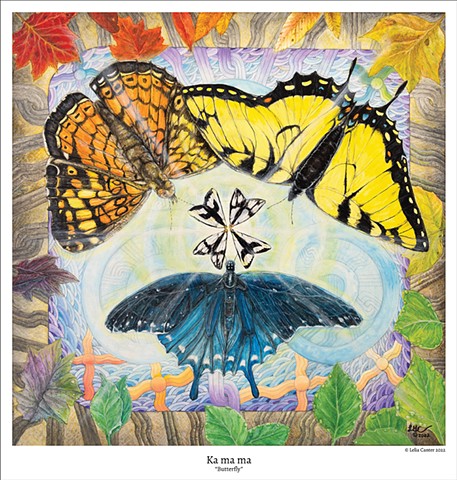Art Work
Ka ma ma (Butterfly), acrylic, © 2022, Lelia Gina Canter.
Ka ma ma, is the Cherokee word for Butterfly.
Butterflies are universal symbols of beauty and happiness and have been the subject of many cultural stories and legends throughout history. They have been a subject of art, poetry, and song for thousands of years.
Many cultures around the world believed that the dead were reborn as butterflies. Irish legends say that butterflies hold the souls of the dead until they pass into Purgatory. The ancient Greek word for butterfly was the same as their word for soul...'psyche'.
In Native American legend, butterflies could help wishes come true and carry dreams to us when we sleep.
The Cherokee and Shoshone peoples have a special ceremonial dance called the Butterfly Dance or Fancy Shawl Dance where the women use brightly colored shawls to represent butterfly wings.
The Cherokee Legend of the Butterfly tells the story of tragedy and the eventual rebirth of happiness, as a woman who has lost her love travels the earth with her wings packed away, until her sorrow was finally healed and she was reborn. She was so happy she removed her cocoon and began to dance to give thanks for another chance to begin her life anew. Then she went home and told The People about her long journey and how it had healed her.
To this day, The People dance this dance as an expression of renewal, and to give thanks for new seasons, new life, and new beginnings. The shawl in the Fancy Shawl Dance represents the butterfly’s wings, the fancy steps and twirls represent the butterfly’s flight. This is another reason you will sometimes hear the Fancy Shawl Dance referred to as “the Butterfly Dance.”
The butterflies, moths, and foliage shown in the painting are some of the many species seen and documented by the artist near her home in the Appalachian mountains of North Carolina.
The Appalachian Tiger Swallowtail, Papilio appalachiensis, (upper right) is a species of swallowtail butterfly found in eastern North America, particularly along the cool woodland slopes of the Appalachian Mountains.
The Pipevine Swallowtail, Battus philenor, (at bottom) is typically found along woodland borders, clearings, roads, or wide trails through hardwoods or mixed woods.
The Northern Crescent, Phyciodes cocyta, (upper left) inhabits small forest openings, road cuts, and woodland edges, mainly in middle (2500-4000 feet) elevations.
The Clymene Moth, Haploa clymene, (at center) is noted for the striking upside-down cross pattern on its forewings. Because of this design, some people refer to it as the “Crusader Moth.” A member of the Tiger Moth family, the Clymene Moth can be seen flying day or night typically inhabiting deciduous forests and fields.
Leconte's Haploa Moth, Haploa lecontei, (at center) may have a distribution covering the western two-thirds of the state and appears to occupy a moderately wide range of habitats. feeding on many species of herbaceous and woody plants specifically Apple, Eupatorium, and Willow.
Limited Edition Prints Also Available
Limited Edition Prints and Greeting Cards Available.
